The marble ballroom is a space into which we enter primed for social drama. We take our positions on the periphery of the dancefloor, an act that marks us as an audience, the social wallflowers. As we do that, five dancers (two men, three women) wearing bright white sneakers and tight black costumes, the latter embellished with sequins and fringes for shimmying, take their turns at the centre of the floor to perform introductory solos. A soft brushing sound accompanies their sweeping feet through a repeated sequence of precise, geometric steps and glissades that register subtly with a rectilinear gridded pattern in the marble beneath their sports shoes.
Thus we were introduced to Moriah Evans’s Social Dance1–8: Index (2015), the last performance to take place at ISSUE Project Room’s home in a former jewel-box theatre in downtown Brooklyn, before the space closed to undergo a major refurbishment due to be completed in 2016. As they moved through each sequence, Evans’s dancers performed energetic, supremely technical routines until sweat dripped visibly down their cheeks. The impression was nonetheless minimal, appearing drawn from a stripped-back choreographic grammar gathered from dancehalls, discos and ballrooms – line dancing, grapevines, circles, triangles, waltzes and so on – and set to a slow synth sound, reminiscent of echoing folk pipes that had been extended interminably.
Perhaps in response to the fact that socialising online is a pastime that is choreographed by unseen, algorithmic forces, lately I’ve seen a smattering of performances that make social operations manifest. Evans’s training is split between dance and art history, and it seemed that the intersection of these practices, a performance of choreographed sociality, were most compelling here. The dancers performed as a tight social group that would split off into efficiently articulated couples, schoolyard allegiances, factions, friendships and other dynamics less easy to articulate. At one point in a duet danced by a male/female couple, after much peacocking, each cheerfully reached around and squeezed the other’s buttocks. The interlinked dramas of the entire group, however, were never so clear as in the moment when the performers held hands in a circle, each smiling with flirtatious, barely concealed mirth, at another member of their circle.
Following the eyeline of each, however, it was clear that each dancer was looking at another who was not returning their gaze. The great ballroom scenes of literature are just a heartbeat away – think of the way a humiliating misplaced look during a waltz in Tolstoy’s Anna Karenina (1877) temporally bloats a single moment: ‘long afterwards – for several years after – that look, full of love, to which he made no response, cut her to the heart with an agony of shame.’
Tinder and the like expand the dating pool to encompass strangers once more, as balls and other organised dances did in previous eras
Indeed, whether it takes place among lovers or strangers, there was still embarrassment in this social theatre when it comes to participation from the sidelines. Though any embarrassment is localised, the dancefloor remains a more daunting space on which to perform than an online platform. The hand-holding dancers moved to the sidelines, extending a hand to a gentleman audience-member in invitation. “No… THANK YOU”, he blurted in sheer terror, presumably fearing that he would be dragged towards the floor to dance. The dancers gently, smilingly, persisted, taking his hand. The relief was palpable as they simply continued to dance in their circle while parasitically glommed onto the hands of he and another audience member. Google’s persistent, somewhat pathetic insistence that we join ‘Google Circles’ drifted through my consciousness.
It wasn’t the only platform that Evans’s work would bring to mind. Later, reading a defence of Tinder in The New York Times by psychology professor Eli J. Finkel, Evans’s choreography returned to me. Finkel’s assessment is that the swipe-right-for-yes, left-for-no app is, in certain aspects, a return to a pre-Internet model of romance. While it might simultaneously operate as an ice-cold, mechanistic hookup app, Finkel suggests that Tinder and the like expand the dating pool to encompass strangers once more, as balls and other organised dances did in previous eras. The social dance with proximal strangers returns then: dance card for iPhone, sweeping feet for a finger sweeping right: mutatis mutandis. Both are forms of coded conduct, though digital codes are marginally harder to see in operation, and thus to manipulate. I write this from a café, where my current assessment is that the couple on the next table are on a Tinder date. Then again, maybe it’s a work meeting. Who can tell? Only they and the algorithms.
This article was first published in the April 2015 issue.
